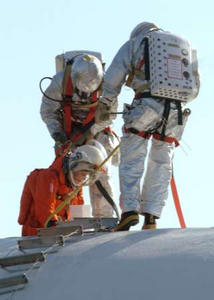NASA will put a backup shuttle on every mission * Following the Columbia disaster, NASA decided to change the existing procedures. When one space shuttle penetrates the limits of the atmosphere, a second equipped and manned shuttle will be waiting for it, ready to go on a rescue mission
 Rescue teams at the Kennedy Space Center this week performed a dry test in which they practiced a shuttle crash, the first test of its kind since the Columbia disaster.
Rescue teams at the Kennedy Space Center this week performed a dry test in which they practiced a shuttle crash, the first test of its kind since the Columbia disaster.
Although shuttle flights have been suspended since the disaster, on February 1, 2003, senior officials want to keep emergency crews trained in the unlikely event of a similar incident.
"We know that if we ever need this, it will be the most important thing to do," says Robert Hall, NASA's launch recovery manager who led the experiment.
Disaster simulation systems were placed on board the Canaveral as early as 1960 when a typical spacecraft was a Mercury compartment with room for one astronaut.
In the scenario practiced on Wednesday, the shuttle commanders discovered a malfunction during the final landing maneuvers and the shuttle crashes about 4 kilometers short of the landing strip. For the purpose of the example, a model of the passenger cabin of the shuttle was dropped into the swamp area near the Kennedy base. The members of the rescue teams who looked like astronauts themselves in suits to protect against dangerous substances in helmets and carrying oxygen tanks on their backs, arrived at the scene in US Air Force helicopters.
Such a rescue can be dangerous because the shuttles carry fuel that can burn out the light and suffocate the lungs. Seven people played the role of the astronauts in the exercise and notes attached to various places in their suits detailed their injuries and the symptoms they were suffering from. Their conditions were varied - from a minor injury to a serious head injury.
It took 45 minutes for the five rescue helicopters to find the fragments, lower firefighters and medics to the ground and free the survivors, and give them the necessary medical treatment.
Brigadier General John Beckett of the Manned Space Flight Assistance Unit at nearby Patrick Air Force Base said the experiment was a success. The goal is always to get medical attention in the critical minutes, Bickett said.
Crash drills are held once a year, but last year the forces were busy with a real operation and the exercises were cancelled. About once every two years they practice emergency rescue in the ocean. NASA had hoped to resume space flights in the fall, but apparently these will be postponed until January or even March 2004.
The Columbia disaster occurred at too high an altitude to allow the astronauts to be rescued alive, this was not a forced landing at a relatively low speed and near the landing site as in the scenario for which the crews train. Therefore, the crews in the exercise did not know at first whether they would see a crew cabin submerged in mud and the people inside it alive or a charred cabin and people whose notes on their suits said they were dead. "We must prepare for every possibility." said.
NASA is planning a backup shuttle for flights
The American space agency announced that starting next year, when a space shuttle returns from a manned mission, another manned and equipped shuttle will be kept on standby on the ground, in case a rescue from space is necessary.
The purpose of the contingency plan is to prevent another disaster similar to the Columbia disaster, in which seven astronauts were killed. In a situation where the first shuttle cannot land safely on the ground, the second shuttle will go towards it and safely return the crew members.
Last month, out of safety considerations, pressure was put on NASA to cancel the expedition intended to repair the Hubble Space Telescope. NASA hasn't planned a rescue mission since the 70s. At that time, the space agency designed the Apollo cockpit so that there would be room for five more astronauts, should they not be able to return to their cabin.
"There will be more changes on the first flight"
NASA is dealing with a problem that experts, who specialize in predicting disasters, have warned about since the investigation of the Columbia disaster. Following the explosion of the shuttle while trying to re-enter the atmosphere, NASA passed a series of reforms designed to prevent a similar situation in the future.
"It is likely that there will be more changes in the first flight than there were in previous flights," said Michael Kostelnik from NASA. NASA expects to announce in the coming days a new launch date for the space mission. The launch is planned for September of this year, but will probably be delayed until the beginning of 2005. NASA must also decide which of the two available shuttles, "Atlantis" or "Discovery", will go on the flight.
